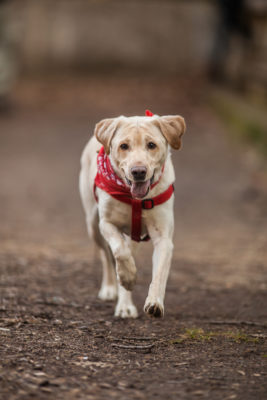
For you to understand our topic more fully, we want you to take part in a little experiment that will require space.
Stand up and spread your feet far apart. Got it?
Now run.
You didn’t get very far with any kind of speed or efficiency, did you. If you put your feet together and try running again, you’ll notice a world of difference. The exercise helps you understand more vividly the efficacy of “single tracking” for a dog. When a dog’s feet converge towards a center line of gravity underneath her body as she moves from a walk to a trot, she is better able to maintain balance, and this is called single tracking.
When walking, a dog can support her body with three legs as one foot moves forward, but as she speeds up and changes gait, she has less support which is why her legs move toward the center of mass directly below her body. When you think back to how you ran with your feet wide apart, you’ll recall that your body swayed side to side. Single tracking enables a dog to decrease the lateral oscillations of her body while providing continual support of her center of mass.
Some dogs will single track with their front feet, but move wide apart with their rear feet, and some dogs do the opposite. Sometimes this movement is reversed. But by moving a dog’s center of gravity along a straight line without deviating from right to left (like you did when you swayed while running with your feet wise apart), the dog doesn’t fight gravity, she uses it with each footfall that strikes directly under her kinetic center of gravity. The faster she moves, the more convergence is apparent, and the more energy she saves. This is the beauty of single tracking, or what some fanciers call true convergence.
A dog’s height and length of leg influences the tendency to single track, so it follows that wide-set breeds with low centers of gravity (think Bulldog or Corgi) don’t single track, but they may move with a roll or lateral displacement that in any other breed with longer legs might be considered unsound, if not downright abnormal. As Dr. Pete Emily reminds us, these wide-body breeds tend to place their footfalls on a convergent plane along each side of an imaginary line.
Some breeds – ones that are longer legged, longer bodied or with unique fronts – use a variation of single tracking, and some manage it by keeping their elbows close to their body. The same principal holds: They should demonstrate footfalls that incline toward the midline. Depending upon the breed, failure to single track results in fatigue, stress on the dog’s body, and even damage. A dog that double tracks, or moves with limbs parallel, is apt to roll at higher speeds and lose efficiency. The single tracking keeps the dog in balance as the weight is accepted by each diagonal pair of legs at the trot.
If you want to learn more about gaits, be sure to check out this nifty chart that breaks down what foot is where during various gaits.
Image: Labrador Retriever/Dreamstime
